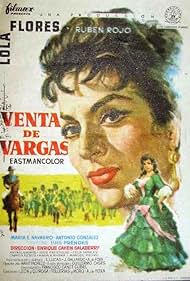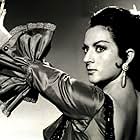Aggiungi una trama nella tua linguaDuring the Napoleonic invasion of Spain Dolores, singer and dancer at a venta (inn), uses her position to help the Spanish resistance.During the Napoleonic invasion of Spain Dolores, singer and dancer at a venta (inn), uses her position to help the Spanish resistance.During the Napoleonic invasion of Spain Dolores, singer and dancer at a venta (inn), uses her position to help the Spanish resistance.
Foto
María Esperanza Navarro
- Isabel
- (as María E. Navarro)
Antonio González 'El Pescaílla'
- Antonio 'El Fraile'
- (as Antonio González)
Trama
Lo sapevi?
- QuizLola Flores can be here seen with his real husband Antonio González "El Pescadilla", who often accompanied her playing Spanish guitar on and off the stage, and with sister Carmen Flores who plays Curra.
- Colonne sonoreVenta de Vargas
By Juan Tellería (as Tellería) and Moro
Recensione in evidenza
Set during the Napoleonic invasion of Spain , stars Dolores (Lola Flores) , a singer and dancer at a inn , she's the region's most beautiful gypsy who dances and sings before a large public . Meantime, the guerrilla and Garrochistas battle the Napoleon's troops which have imposed French rule in 1808 . At the local inn she uses her position to help the Spanish resistance . There appears the leader of an underground armed group Antonio 'El Fraile' (as Antonio González , El Pescailla) who formerly participated on May 2, 1808 along with Daoiz , Velarde and lieutenient Ruiz in the Madrid rebellion , and he now wants to join General Castaños (Felix Dafauce) to communicate commands from the Junta Da Madrid and subsequently there takes place the Battle of Bailén . While Dolores seducing Guerrilleros , and soldiers of the French army to get information ; she is , without any doubt , the most valiant woman at the time . As the beautiful gypsy girl entices a young dragoon officer Capitán Pierre (Rubén Rojo) . The free , enigmatic nature of a woman named Dolores , her southern beauty , her passionate , impulsive character and her turbulent loves , uncontrollable passions and jealousy .
Agreeable update on the classic story set in the Spanish Independence period , including a loving triangle , historical events and the typical Spanish clichés . The story is ordinarily melodramatic and plenty of songs , musical spectacle and evocative scenarios . Enrique Cahen Salaberry brilliantly casts one of the most famous Spanish actress of the epoch , Lola Flores , to play Dolores in the kind of steamy role she revels in . As Lola Flores took part in 38 films, making her début in 1939 as an actress with the film Martingala by Fernando Mignon . One of the most remarkable films is a classic from the 40s : Embrujo (1947) , Carlos Serrano de Osma), a musical drama where she accompanies Manolo Caracol , who was her boyfriend in those days . In 1951, Flores signed a five-film contract with Suevia Films for a value of 6-milion pesetas , which became the best paid contract for a performing artist in Spanish history. Under that contract she starred in major productions like La Niña de la Venta (1951) , ¡ Ay, Pena, Penita, Pena! (1953) , La Danza de los Deseos (1954) and El Balcón de la Luna (1962) , among many others , which spawned the signature songs "A Tu Vera" and "¡Ay, Pena, Penita, Pena!". Since then, she was popularly dubbed as La Faraona . In 1951 she signed a contract with Cesáreo González, and thanks to this partnership she performed films such as La niña de la venta, with Ramón Torrado, (1951) and ¡Ay pena, penita, pena! , with Miguel Morayta, (1953). Another of her distinguished films from the 1950s is Morena Clara (1954, Luis Lucia) which was an adaptation of the popular film from 1934, and in company of Fernando Fernán Gómez, El duende de Jerez (1953) and María de la O (1958), she also starred in her first film with Antonio "El Pescaílla" González. Other important films in which this artist took part were El volcán y la brisa , La hermana Alegría in 1954, El balcón de la luna in 1962, Sister San Sulpicio (1962), a new version different from the film in which Imperio Argentina had been involved and the Mexican dramas: La Faraona (1956) and Sueños de oro (1958) . She also acted in a film with them: El balcón de la luna (1962, Luis Saslavsky). Furthermore , Casa Flora (1972, Ramón Fernández) and Una señora estupenda (1972, Julio Coll) are two of the most acceptable films of the period known as predestape in the Spanish comedian film industry . After this period she was the protagonist of the comedy Juana la loca... de vez en cuando (1983), where she would represent Isabella I of Castile, a very important Queen during the Spanish Inquisition , Truhanes (1983, Miguel Hermoso). Her last role in the cinema industry was in 1992 with Sevillanas, whose director was Carlos Saura . In this film, she shared experiences with the most remarkable icons of Flamenco, such as Camarón de la Isla or Rocío Jurado . Her friendship with Carmen Sevilla and Paquita Rico, who were folkloric artists and actresses is very well-known . She took part in different musical tours around South America.
La Faraona is well accompanied by a fine main and support cast , such as : Rubén Rojo , Antonio González 'El Pescaílla' Antonio González 'El Pescaílla' , Jesús Tordesillas , Félix Dafauce as General Castaños , Carmen Flores , Antonio Molino Rojo , José Riesgo , José Calvo , Rufino Inglés and Luis Prendes as Comandante De Moulin. The motion picture was regular but professionally directed by Enrique Cahen Salaberry.
Agreeable update on the classic story set in the Spanish Independence period , including a loving triangle , historical events and the typical Spanish clichés . The story is ordinarily melodramatic and plenty of songs , musical spectacle and evocative scenarios . Enrique Cahen Salaberry brilliantly casts one of the most famous Spanish actress of the epoch , Lola Flores , to play Dolores in the kind of steamy role she revels in . As Lola Flores took part in 38 films, making her début in 1939 as an actress with the film Martingala by Fernando Mignon . One of the most remarkable films is a classic from the 40s : Embrujo (1947) , Carlos Serrano de Osma), a musical drama where she accompanies Manolo Caracol , who was her boyfriend in those days . In 1951, Flores signed a five-film contract with Suevia Films for a value of 6-milion pesetas , which became the best paid contract for a performing artist in Spanish history. Under that contract she starred in major productions like La Niña de la Venta (1951) , ¡ Ay, Pena, Penita, Pena! (1953) , La Danza de los Deseos (1954) and El Balcón de la Luna (1962) , among many others , which spawned the signature songs "A Tu Vera" and "¡Ay, Pena, Penita, Pena!". Since then, she was popularly dubbed as La Faraona . In 1951 she signed a contract with Cesáreo González, and thanks to this partnership she performed films such as La niña de la venta, with Ramón Torrado, (1951) and ¡Ay pena, penita, pena! , with Miguel Morayta, (1953). Another of her distinguished films from the 1950s is Morena Clara (1954, Luis Lucia) which was an adaptation of the popular film from 1934, and in company of Fernando Fernán Gómez, El duende de Jerez (1953) and María de la O (1958), she also starred in her first film with Antonio "El Pescaílla" González. Other important films in which this artist took part were El volcán y la brisa , La hermana Alegría in 1954, El balcón de la luna in 1962, Sister San Sulpicio (1962), a new version different from the film in which Imperio Argentina had been involved and the Mexican dramas: La Faraona (1956) and Sueños de oro (1958) . She also acted in a film with them: El balcón de la luna (1962, Luis Saslavsky). Furthermore , Casa Flora (1972, Ramón Fernández) and Una señora estupenda (1972, Julio Coll) are two of the most acceptable films of the period known as predestape in the Spanish comedian film industry . After this period she was the protagonist of the comedy Juana la loca... de vez en cuando (1983), where she would represent Isabella I of Castile, a very important Queen during the Spanish Inquisition , Truhanes (1983, Miguel Hermoso). Her last role in the cinema industry was in 1992 with Sevillanas, whose director was Carlos Saura . In this film, she shared experiences with the most remarkable icons of Flamenco, such as Camarón de la Isla or Rocío Jurado . Her friendship with Carmen Sevilla and Paquita Rico, who were folkloric artists and actresses is very well-known . She took part in different musical tours around South America.
La Faraona is well accompanied by a fine main and support cast , such as : Rubén Rojo , Antonio González 'El Pescaílla' Antonio González 'El Pescaílla' , Jesús Tordesillas , Félix Dafauce as General Castaños , Carmen Flores , Antonio Molino Rojo , José Riesgo , José Calvo , Rufino Inglés and Luis Prendes as Comandante De Moulin. The motion picture was regular but professionally directed by Enrique Cahen Salaberry.
I più visti
Accedi per valutare e creare un elenco di titoli salvati per ottenere consigli personalizzati
Dettagli
- Tempo di esecuzione1 ora 27 minuti
Contribuisci a questa pagina
Suggerisci una modifica o aggiungi i contenuti mancanti

Divario superiore
By what name was Venta de Vargas (1959) officially released in Canada in English?
Rispondi













